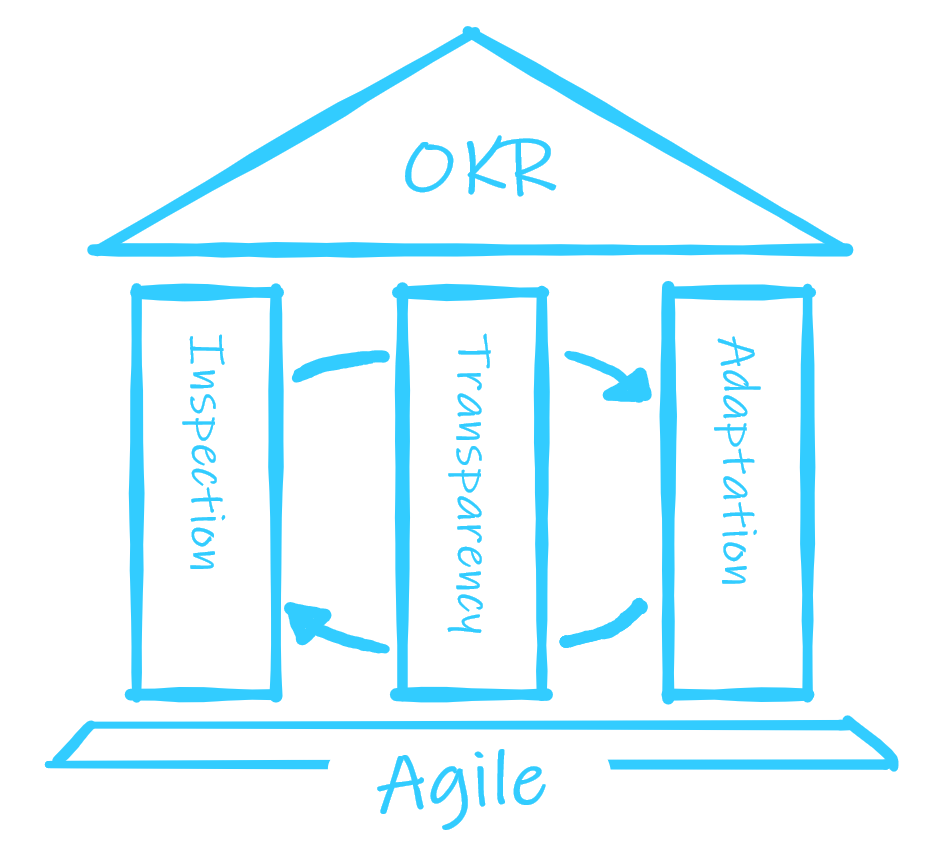
02. Feb 2021
How and why OKRs work for us
OObjectives and Key Results (OKRs) are a method we introduced at XITASO at the end of 2019. Having tried out the framework for a good year now, we are taking stock. Baptiste Grand, agile coach at XITASO shows how and why OKRs work well for us, and what learnings we have been able to take with us so far.
How do OKRs work?
OKRs are a method of establishing and tracking strategic alignment within an organization. The Objective and Key Results Framework helps to define annual targets (moals), align quarterly goals (objectives) with them, and to verify the achievement of the targets using concrete metrics (key results).
OKRs as an agile management method
The basic concept of OKRs is very easily understood, however it is difficult to master it correctly. The OKR framework can be identified as an agile practice because transparency and an incremental approach combined with constant reviews and adjustments play decisive roles. The OKR framework has similarities with Scrum as a Management 3.0 method, in some respects.
Just like Scrum, the OKR framework is based on an iterative and incremental approach with a fixed time cycle, which is normally one quarter. The results of each cycle are oriented towards achieving the annual target. At the end of each cycle, progress is reviewed in relation to the planned objectives. According to needs, adjustments are constantly enacted with the aim of continuously improving the process.
Objectives and Key Results
The objectives are derived from a company’s vision, mission, and annual targets. The key results are concrete, specific and measurable measures that are defined in relation to one of the objectives and are intended to contribute to its achievement. Key results are generally measured on a percentage scale, with 70% already representing a success. These stretching goals spur you to set challenging goals and, upon achieving the 70%, to want to surpass them. A regular achievement of 100% reveals that the goals were not set high enough.
What distinguishes the OKR framework from other management methods is, on the one hand, the focus on the cycles and on the other hand the way of dealing with the results. Should an objective not be achieved, the question is not whose fault it is but rather it focuses on why it went wrong and how it can be improved upon in the next cycle.
Why did we decide for OKRs?
At XITASO, we are organized in Communities of Practice alongside our project teams. Each of our communities has the aim of exchanging information on determined topics like frontend technologies, sales or agile methods and thereby to build up and share knowledge. This has always worked well for us but the more our organization grew the more difficult it became to maintain the regular exchanges between all communities and to pursue common goals.
To ensure that we all pull together and can add the efforts of all our communities to the annual and long-term goals of our organizations, we needed to establish a common strategic direction. The OKR framework seemed be the perfect fit, so we began trying this method out at the end of 2019.
Why do OKRs work for us?
Having implemented the OKR framework for a year in 2020, with a total of three cycles, I can say that this method works really well for us. We’ve found that although the objectives of each community are somewhat similar, some of the key results are very different. This demonstrates that the goals we want to achieve have the same strategic orientation across communities, while the path to achieving them is more the self-responsibility of the communities. I have tried to introduce the OKR Framework on several occasions, before my time at XITASO, but it has always failed. In the meantime, I know where the problems were and can use my experiences to define some important Learnings:
1. Avoid dependencies
A tool can only be considered good when it is used for the correct application: You would not use a hammer to tighten a screw. And if you did then the success rate would not be very high. The same applies to the OKRs: it is a framework for managing the strategic alignment between independent entities. If you use the framework for interdependent units, e.g., component teams, circular dependencies are created when the target is achieved, which will most likely lead to dissatisfaction, excuses, and ultimately the failure of the framework.
2. Strategy ≠ Daily Business
What happens when a team sets itself the objective of doing their daily work? They will most probably just do their job, no more and no less. But if an organization wants to grow and improve, that wouldn’t be expedient. Therefore, the OKRs should never only reproduce daily business, but rather should motivate people to leave tried and trusted paths and try new things out in order to achieve the long-term goals. This is the only way OKRs can help improve organizations, instead of just maintaining the status quo and inevitably repeating it.
3. Inspect AND adapt
And speaking of improvements, here comes the most important piece of advice I have: Don’t forget to learn! It is very unlikely that an organization will implement the OKR framework perfectly from the start, which is why iterations play such an important role. Regularly use review and retro appointments to verify that you have set the right goals, whether you are on the right track to achieve them, and whether you are using the framework correctly. Cycle by cycle, you should get feedback, review the process and plan how to improve it. Important here is to ensure that the ideas for improvement are discussed and then implemented. The key words are “inspect AND adapt” – two words, not one.
Author & contact person
Do you have questions, ideas or feedback on this topic? Feel free to contact us!

Baptiste Grand
baptiste.grand@xitaso.com




